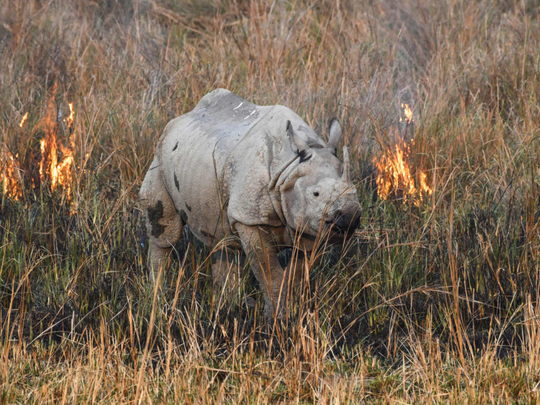
For a whole generation of us, the word “rhino” conjures up that heart-stopping scene from the 1960s film Hatari when an enraged rhinoceros attacks a jeep on the African savannah.
The motives of the characters in Hatari are very different from what we see today, but that scene and the many tales we have heard over the years of animals attacking tourists on safari makes some of us wary of facing animals in the wild. It is more to our liking to watch animal adventures on the television screen or, if we want to see real live animals, view them over a nice safe wall they cannot scale — or across a wide moat they cannot cross.
Some months ago, however, along with more adventurous friends, we visited the northeast of India – rhinoland – and were up early on the first day out, eager for our own personal up-and-close encounter with that animal.
We expected to see a couple of rhinos — with luck — and our thoughts were on the elephant ride that would be a part of the viewing experience (for which we felt more than slightly guilty). As we neared the mounting platform, we got cold feet. Would we be able to get onto the elephant and then, more important, keep our seats on what looked like a precarious perch for a whole two hours while we went over marshy, uneven ground in search of India’s rhinos?
Of course, we need not have worried. Getting on was a breeze and we were firmly “locked in”, in the manner of a seat on a giant wheel, so there was no danger of us toppling over.
None of us had thought to bring a pair of binoculars to get long-distance views or search for camouflaged animals in the tall grass around, but we had little time to rue that. We were hardly out on the plain on our gentle elephant when we saw the first rhino in plain sight.
Our “oohs” and “aahs” were barely above a whisper, because, try as we might, we could not forget Hatari and we did not want to get the rhino riled up enough to charge at the mild-mannered elephant that patiently bore our weight. From its sturdy back we marvelled at the rhino — and at many deer, boars, hares, etc., that shared the rhino’s habitat.
Bird’s eye view
Until we went to “rhinoland”, we had believed that a glimpse of one rhino would be enough to make our entire trip worthwhile, but as our mahout urged the elephant to take us round and about and up and down, we saw rhinos by the dozen. There were groups and individuals and mothers and calves — all going about their own business as we enjoyed our almost bird’s eye view of them. By the time we hopped into an open jeep later in the day to traverse another stretch of “rhinoland”, we had had our fill of rhinos and we were more eager to see which other animals we would spot. We were hoping (some of us not quite as fervently as others), to catch a glimpse of a tiger in the tall grass. We were advised not to wear bright colours and to avoid making a noise and were also told not to eat and drink during our ride – all so that we could treat the animals in that area with the respect they deserve.
Now, as I read about rhinos without borders – the animals that cross over between India, Nepal, Bhutan and Burma – those happy hours of rhino spotting come to mind again. We certainly had our fill for a lifetime and so, perhaps, will others in our neighbouring countries.
Cheryl Rao is a journalist based in India.





_resources1_16a31069e4e_small.jpg)



